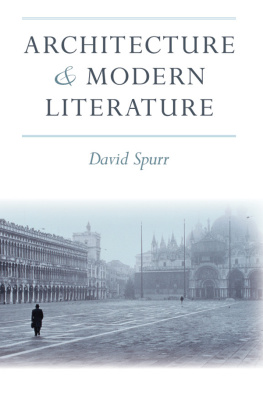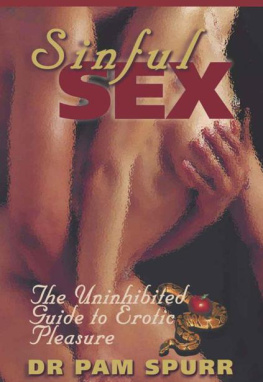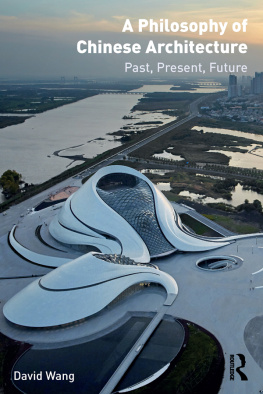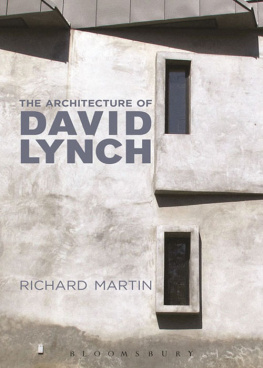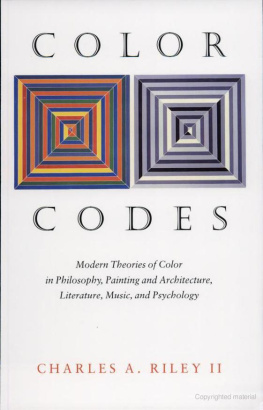David Spurr - Architecture and Modern Literature
Here you can read online David Spurr - Architecture and Modern Literature full text of the book (entire story) in english for free. Download pdf and epub, get meaning, cover and reviews about this ebook. year: 2018, publisher: The University of Michigan Press, genre: Religion. Description of the work, (preface) as well as reviews are available. Best literature library LitArk.com created for fans of good reading and offers a wide selection of genres:
Romance novel
Science fiction
Adventure
Detective
Science
History
Home and family
Prose
Art
Politics
Computer
Non-fiction
Religion
Business
Children
Humor
Choose a favorite category and find really read worthwhile books. Enjoy immersion in the world of imagination, feel the emotions of the characters or learn something new for yourself, make an fascinating discovery.
- Book:Architecture and Modern Literature
- Author:
- Publisher:The University of Michigan Press
- Genre:
- Year:2018
- Rating:5 / 5
- Favourites:Add to favourites
- Your mark:
- 100
- 1
- 2
- 3
- 4
- 5
Architecture and Modern Literature: summary, description and annotation
We offer to read an annotation, description, summary or preface (depends on what the author of the book "Architecture and Modern Literature" wrote himself). If you haven't found the necessary information about the book — write in the comments, we will try to find it.
Architecture and Modern Literature — read online for free the complete book (whole text) full work
Below is the text of the book, divided by pages. System saving the place of the last page read, allows you to conveniently read the book "Architecture and Modern Literature" online for free, without having to search again every time where you left off. Put a bookmark, and you can go to the page where you finished reading at any time.
Font size:
Interval:
Bookmark:
 Page i Page ii Page iii
Page i Page ii Page iii David Spurr
THE UNIVERSITY OF MICHIGAN PRESS
ANN ARBOR
Copyright by the University of Michigan 2012
All rights reserved
This book may not be reproduced, in whole or in part, including illustrations, in any form (beyond that copying permitted by Sections 107 and 108 of the U.S. Copyright Law and except by reviewers for the public press), without written permission from the publisher.
Published in the United States of America by
The University of Michigan Press
Manufactured in the United States of America
 Printed on acid-free paper
Printed on acid-free paper
2015 2014 2013 2012 4 3 2 1
A CIP catalog record for this book is available from the British Library.
Library of Congress Cataloging-in-Publication Data
Spurr, David, 1949
Architecture and modern literature / David Spurr.
p. cm.
Includes bibliographical references and index.
ISBN 978-0-472-07171-5 (cloth : acid-free paper)ISBN 978-0-472-05171-7 (pbk. : acid-free paper)ISBN 978-0-472-02824-5 (e-book)
1. Architecture and literature. 2. Space perception in literature. 3. Literature, Modern19th centuryHistory and criticism. 4. Literature, Modern20th centuryHistory and criticism. I. Title.
PN56.A73S68 2012
809'.93357dc23 2011043633
Page vIn memoriam
Elizabeth S. Ball
- CHAPTER
This is a book about the interpretation of architectural forms in modern literature. One of its claims is that literature's encounter with the built environment is essential to its definition of what is sometimes called modernity, meaning the set of material and symbolic forms that constitute the modern world and our experience of that world. In order to address this subject, I have found it necessary to pose certain larger questions of the relation between literature and architecture. The introduction puts forward the general question of how meaning is produced by architecture and literature, respectively, and how these meanings have intersected. This question is initially addressed in historical terms, ranging from what I choose to call the foundational myths of Babel and the house of Odysseus to the house ideologies of the early modern period. The attention then shifts to the crisis of meaning common to both arts in the nineteenth and twentieth centuries. This crisis manifests itself in a number of ways: in the aesthetics of ruin and fragmentation, in the retreat toward interiority as a space of subjective and private meaning, in the new kinds of attention given to the human body, in the development of new forms and materials, and in the conception of the past in terms of stock or reserve.
The first chapter takes up some of the points raised in the introductory essay in order to recast them within the problematic of architecture as a space of human dwelling, understood in a practical as well as an existential sense. The subject of dwelling is of central importance to this book, as it brings together a range of literary, architectural, and theoretical discourses Page x in which the conditions of modernity are those of crisis: a crisis in human habitation, in the adaptation of human beings to the objective conditions of a world in which the question of what it means to be human is given unprecedented urgency. The question is posed equally, if indirectly, by works as diverse as Virginia Woolf's Mrs Dalloway (1925) and Adolf Loos's Michaelerplatz building in Vienna (1911). The specifically modern concept of dwelling seeks reconciliation with the ontological condition that Martin Heidegger names homelessness (Heimatlosigkeit). Homelessness in this sense is the other of the traditional concept of dwelling, along with the conditions of ruin, fragmentation, and exile. It means not just lacking shelter but not being at home in the world, including the world of language. Modern literature and architecture are the consequences of this condition, in both their formal freedoms and their respective engagements with the question of the way we live now.
The chapters that follow explore from different angles the question of dwelling and its other, beginning at the turn of the nineteenth century and ranging through the twentieth century and beyond. The second chapter concerns the space of the demonic in Sade, Dickens, and Kafka. The demonic is understood here as embodying both the uncanny forces within human being which the modern world has failed to bring under the control of rational mastery, and as the destructive element within the construction of modernity itself.
The chapter on demonic spaces is concerned, in part, with modernity's relation to a premodern and even prehistoric past. The third chapter, on allegories of the Gothic, turns to the modern relation to the Middle Ages by examining the curious variety of nineteenth-century literary responses to the abiding presence of medieval Gothic cathedrals, notably in France. These responses, which range in register from Goethe's sense of the sublime to Henry James's self-deprecating irony, prove to be symptomatic of the perplexity and sense of loss with which the modern sensibility contemplates the architectural evidence of a faith that once united the European world in its collective strength and fervor. Behind this perplexity is not just the enigma of modernity's relation to the past but also the problem of the nature of aesthetic experience in a world where art is removed from its traditional foundations in ritual and worship.
The following chapter, on Ruskin and Viollet-le-Duc, pursues the general subject of the Gothic by comparing the two most important writers on architecture in the nineteenth century in their conflicting ideas concerning the restoration of medieval architecture. Once again it is a question of modernity's relation to the past. Ruskin revives the eighteenth-century aesthetic Page xi of the ruin in wishing to preserve the effects of time on medieval architecture, whereas Viollet-le-Duc attempts to modernize the Gothic in order to restore it to an ideal form that it may never have actually had. The opposition between these architectural values is compared to that which exists in modern literature between the figures of allegory and symbol as contrasting modes of representing the relation of the past to the present.
The chapter on Proust in Venice carries the question of the past into the twentieth century. Whereas in a writer like Balzac, the progress of his hero's life is defined according to his ability to negotiate the labyrinthine ways of the social space of Paris, in Proust the narrator experiences urban space as a kind of map of his own memoryas a metaphorical projection of the personal metaphysics of time in which he struggles to unite his present with his past. The historical memory embodied in the architecture of Venice thus serves as a model in the narrator's search for a way to relive the privileged moments of his own memory. The problem of history is equally important for Joyce: in Ulysses the modern city emerges as a great palimpsest in which architectural objects built in different historical epochs are juxtaposed with one another so as to transform their respective meanings in a manner similar to the way this happens between the archaic and modern elements of Joyce's language.
The chapter on architecture in Frost and Stevens returns to the metaphysics of dwelling in order to show how, in an era when the traditional myth of dwelling can no longer be revived, modern poetry assumes the task of defining a new relation to dwelling, as a mode of being, in the form of poetic language itself. The difference between the two poets lies in the respective meanings they assign to this dwelling in relation to the more universal conditions of being. The final chapter examines the literary response to the modular, temporary, and cumulative architectural forms produced by the adaptation of building technology to the imperatives of mass consumption and globalizationwhat the architect Rem Koolhaas has called junkspace. The works of J. G. Ballard and Michel Houllebecq serve as testimonies to radical transformations in subjectivity and the social fabrictransformations seen as intimately related to specifically contemporary architectural forms, such as the high-rise apartment building, the corporate office park, the suburban shopping mall, and the highway interchange. Our reading of these works brings us back to the question of dwelling, both in historical time and in the space of the present, and of the need to find a way to live in a world in the absence of any necessary relation between the human subject and the built environmentwhere dwelling always has to be learned or invented anew.
Next pageFont size:
Interval:
Bookmark:
Similar books «Architecture and Modern Literature»
Look at similar books to Architecture and Modern Literature. We have selected literature similar in name and meaning in the hope of providing readers with more options to find new, interesting, not yet read works.
Discussion, reviews of the book Architecture and Modern Literature and just readers' own opinions. Leave your comments, write what you think about the work, its meaning or the main characters. Specify what exactly you liked and what you didn't like, and why you think so.

